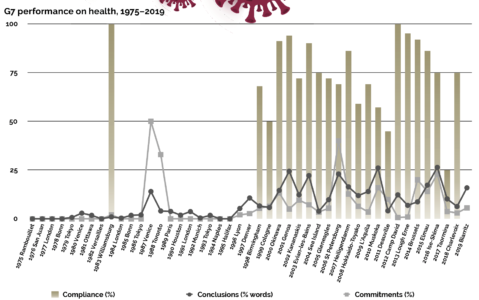G7 performance on health
The G7’s performance on health falls below the average across all issue areas, but, says Meagan Byrd, chair, summit studies, G7 Research Group, leaders can improve compliance by holding health ministers’ meetings, reaffirming support to international organisations and making binding commitments on global health systems
From the Rambouillet Summit in 1975 to the Biarritz Summit in 2019, the G7 leaders dedicated 49,816 words (8%) to health in their summit documents, averaging 1,107 words per summit. However, they paid little attention to health prior to 1996. Their focus increased considerably between 2000 and 2007. The highest number of words dedicated to health at a single summit was in 2006, where the G7 produced 7,072 words on health. The lowest was in 1984, with only 12 words (0.4%) on health. The G7 produced a total of 76 dedicated documents on health, starting as early as the 1979 summit.
Commitments
The G7 made 415 collective, precise, future-oriented, politically binding commitments on health as identified by the G7 Research Group, averaging nine commitments per summit. Health ranked third highest among the 32 subjects on which the G7 leaders made commitments. The first health commitment was made in 1979, with a steady increase from 1996 onwards. From 2000 to 2008, the G7 showed consistent and sustained attention on health, but this focus declined from 2009 to 2012. Focus increased again in 2014 with 12 health commitments, rising to 61 in 2015 and peaking at 86 at the Ise-Shima Summit in 2016. This decreased to seven health commitments in 2017 and fell again to only four at Biarritz in 2019.
Compliance
The G7 Research Group has assessed 70 health commitments for compliance by G7 members. Average compliance was 70%, lower than the average of 76% with all assessed commitments across all subjects.
The earliest commitment assessed, with 100% compliance, was made at the 1983 summit. Perfect compliance was only seen once more, with a commitment made at the 2012 summit. From 2000 to 2003, the G7 members had strong compliance, with 91% for 2000, 94% for 2001, 72% for 2002 and 90% for 2003. This strong streak followed a low of 50% for 1999.
From 2012 to 2015, the G7 had another streak of high compliance. After 100% for 2012, compliance was 95% for 2013, 92% for 2014 and 86% for 2015. This second streak followed the second lowest score of 45% for 2011.
Compliance after 2015 was inconsistent, starting with a high of 86% for 2015, 75% for 2016 and 25% for 2017 – the lowest score in the past five years. Compliance soared once again for 2018, reaching 75%. The interim compliance report for the 2019 summit, covering implementation up to 10 December 2019, showed reduced compliance of 50% across the three priority health commitments assessed.
From the start, Canada had the highest compliance with 92%, followed by the United States and the United Kingdom with 88% and 85%, respectively. Italy had the lowest compliance, with 58%.

Corrections
G7 summit health compliance can be improved by holding meetings of health ministers. The three years with such meetings for which compliance data is available (2006, 2015 and 2016) had average summit health compliance of 80%, well above the overall health compliance average of 70% since 1983. Moreover, making connections between health and closely related issues such as climate change, environment, gender equality, employment and development could also increase compliance.
At their next summit, G7 leaders should make more health commitments that specifically reaffirm support for other international organisations, notably the World Health Organization. The G7 Research Group assessed compliance with six commitments that specifically note the WHO and found average compliance of 87%, much higher than the 70% health average.
The G7 should also make binding commitments on global health systems, such as development finance for emergency responses, especially for fighting pandemics, universal health coverage, and primary and emergency healthcare.












